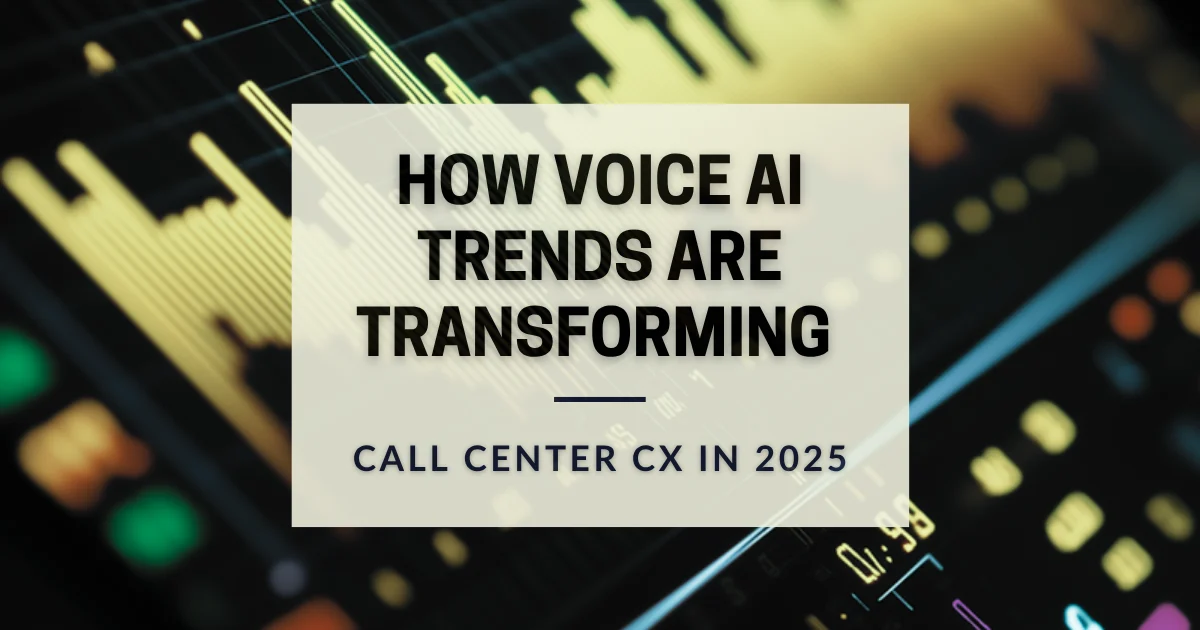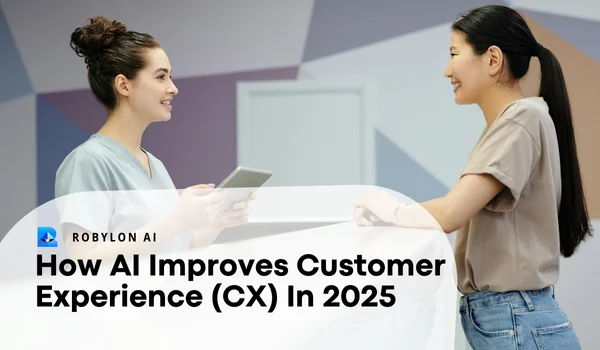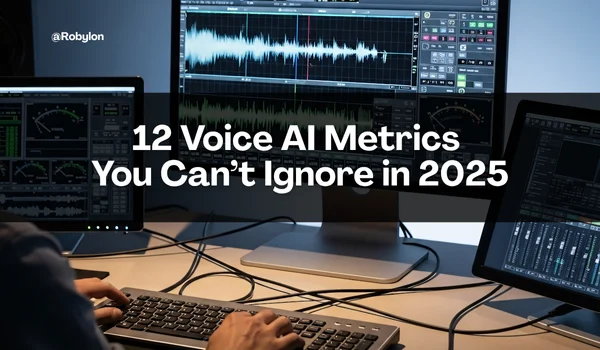TL;DR
- Voice AI Agents in call centers are moving from pilots to scale because they cut Average Handle Time (AHT), lift CSAT, and raise First Contact Resolution (FCR) at once
- Ten clear trends lead the shift: Hyper-natural Voice, Context and memory, real-time agent assist, Multilingual voices, no-code builders, Deep analytics, agentic IVR, low latency, PII redaction, and revenue wins
- Teams succeed by starting with 2–3 high-volume intents, tracking containment and quality, and expanding only when results hold
- A simple buyer checklist keeps programs safe: speed, accuracy, memory scope, guardrails, integrations, analytics, security, reliability, operations, and proof.
Book a demo to see how leading CX teams are already using Voice AI Agents to achieve these results.
Introduction
Voice remains the channel people choose for urgent or complex issues. In 2025, it will no longer be run by rigid IVRs. It is powered by Voice AI, which listens, understands, and speaks in real-time.
Enterprise teams are adopting it because the value is visible every day. Calls finish faster. First-contact resolution improves. Customer satisfaction rises. Leaders can finally measure what happens on calls and fix the root causes, not just the queue.
This guide breaks down the top Voice AI trends shaping modern contact centers and how to implement them with low risk. You will see where each trend fits, which industries benefit most, and how to move from a clean pilot to scale without surprises.
What is Voice AI
Voice AI is software that listens, understands, and speaks in real time. It uses ASR/STT, NLU, and TTS to hold natural phone conversations. It plugs into your contact center, CRM, and knowledge base to fetch context and complete tasks.
With Voice AI, customers get clear answers fast. Agents get fewer repeat queries. Leaders get better voice analytics and control. Voice AI is now used for IVR containment, order status, payments, collections, and appointment booking.
Want a full walkthrough of how modern AI voice agents work? Check out - The Ultimate Guide to AI Voice Agents in 2025.
Top 10 Voice AI Trends
Trend 1: Hyper-natural speech that sounds human
Modern Text-to-Speech (TTS) systems now replicate tone, pacing, and pauses so naturally that most callers can’t tell they are speaking to an AI. But the real breakthrough comes when this lifelike TTS is paired with high-accuracy Speech-to-Text (STT) tuned for live contact center audio.
When your STT engine accurately transcribes speech, even with background noise, accents, or overlapping talk, it reduces transcription drift and ensures both the AI and human agents understand callers the first time. The result: fewer repeats, smoother turn-taking, and faster resolutions.
How to deploy it effectively?
- Start small: Focus on high-volume intents like order status, payment updates, and appointment changes to train and calibrate your models.
- Add precision: Build a custom vocabulary and pronunciation glossary for product names, regional accents, and brand-specific terms.
- Track what matters: Monitor key metrics such as Word Error Rate (WER), barge-in handling, and average handling time (AHT) improvement by intent.
- Retrain with care: Use anonymized transcripts to retrain models regularly and maintain accuracy below 5% WER on live calls.
- Scale with confidence: Once speech recognition is stable, expand to multilingual or complex intents without compromising response quality.
This pairing of refined STT and expressive TTS delivers more natural, efficient conversations, helping agents stay sharper and customers feel truly heard.
Dominant in: Retail and e-commerce, Healthcare, Fintech, Travel, Telecom, BPO
Trend 2: Context-retaining conversations that cut handling time
Context is what turns a voice call from a transaction into a smooth, human-like dialogue.
Modern LLMs and NLU models now maintain short-term memory within a session, while Retrieval-Augmented Generation (RAG) fetches facts from your knowledge base (KB) or CRM in real time. This lets the AI agent recall details mid-conversation, like order history, plan type, or previous complaints, without asking the customer to repeat themselves.
Benefits
- Fewer repeated questions and faster resolution.
- Reduced transfers and after-call work.
- Auto-generated summaries and dispositions in seconds.
Best Practices
- Scope memory carefully - Keep context session-bound and reset it on transfer or call end.
- Protect privacy - Mask or redact all PII before storing transcripts.
- Start with context-heavy intents - Plan changes, troubleshooting, or billing queries are ideal.
- Measure impact - Track metrics like
- Follow-up question count
- First Contact Resolution (FCR) for multi-step intents
- Average Handle Time (AHT) reduction
- Summary accuracy and error rate
How to improve performance?
Publish a weekly baseline, review analytics, and refine prompts or retrieval scopes. Over time, your model learns to recall only what matters, keeping calls short, accurate, and more natural.
Dominant in: Telecom, Fintech, Health Insurance, SaaS Support, Utilities, BPO
Trend 3: Real-time agent assist becomes standard
Agent assist tools are now a staple in modern contact centers. They listen to ongoing conversations, understand customer intent, and guide human agents with live recommendations. These systems can instantly surface the right knowledge base snippet, form, or procedure, suggest tone and phrasing, flag compliance risks, and even auto-generate wrap-up notes directly into the CRM.
The impact is immediate: new-hire ramp time shortens, call quality improves, and supervisors gain live visibility into every call for real-time coaching and feedback.
How to implement it effectively?
- Connect key systems: Integrate Agent Assist with your knowledge base (KB) and CRM to pull real-time context and ensure seamless updates.
- Set clear guardrails: Define what actions the assist tool can take automatically (e.g., prompt suggestions, information display) and where human approval is needed.
- Optimize for top intents: Start by tuning prompts for your five most frequent call types, such as billing queries, onboarding, or support requests.
- Track key metrics: Monitor improvements in Average Handle Time (AHT), First Contact Resolution (FCR), and after-call work (ACW) reduction.
- Enable live coaching: Give supervisors a real-time dashboard view so they can observe, intervene, and train agents as conversations happen.
With real-time agent assist, contact centers evolve from reactive operations into proactive, insight-driven teams that maintain consistency, compliance, and empathy across every call.
Dominant in: BPO, Banking & Lending, Insurance, Telecom, Travel, Government Services
Trend 4: Multilingual voice and accent technology
Today’s customers expect to be heard in their own language and accent. Modern multilingual voice agents automatically detect the caller’s language and switch seamlessly during the conversation. Accent adaptation tools further improve clarity on both ends, ensuring natural, inclusive, and frustration-free interactions.
Best practices for multilingual deployment
- Start with transparency: Use a brief disclosure at the start of the call, and always offer a human handover when the conversation becomes complex or emotional.
- Build localized glossaries: Maintain a mini glossary for each supported language, including brand names, addresses, and industry-specific terms.
- Route by region and model: Assign calls to the best-performing voice model for that region or language, tuned for local dialects and pronunciations.
- Run linguistic quality checks: Test recognition and pronunciation accuracy for numbers, dates, and names, which are common pain points.
- Track multilingual metrics: Measure containment by language, transfer rates, and CSAT per market to identify where translation or tone tuning is needed.
When implemented right, multilingual and accent-aware voice AI bridges global audiences without losing empathy or accuracy, making it a vital step for any enterprise scaling across regions.
Dominant in: Global e-commerce, Airlines & Travel, Banking in Emerging Markets, Telecom, Public Sector Hotlines, BPO
Trend 5: No-code builders and faster deployment
Contact center operations teams now expect results in weeks, not quarters. Modern no-code voice AI builders empower non-technical teams to design conversational flows, define prompts, and connect backend systems, all without writing code.
How does no-code voice AI accelerate deployment?
- Template-driven design: Use ready-to-launch templates for common workflows like returns, collections, order tracking, and address updates.
- Policy and versioning guardrails: Each build runs within controlled versions, ensuring safe experimentation during live hours without risking compliance.
- Incremental rollout: Map one end-to-end call path, add data validation and escalation rules, then ship to 10% of traffic first.
- Continuous feedback loop: Review analytics daily, track containment, call success, and user sentiment to make small iterative improvements rather than large, disruptive overhauls.
This modular approach reduces engineering dependency and allows business teams to respond faster to customer trends and seasonal volume spikes, a crucial edge in 2025’s agile enterprise landscape.
Dominant in: Retail & D2C, Fintech Servicing, Health & Wellness, Edtech, Logistics & Delivery, SMB Contact Centers
Trend 6: Real-time voice analytics goes deeper
Modern contact centers now rely on real-time voice analytics to understand what’s happening during every conversation, not hours later. Today’s systems analyze tone, sentiment shifts, silence duration, talk-over moments, and keyword trends in live calls.
What does it mean for enterprises?
- Live sentiment detection: Supervisors see customer emotion in real time and can jump in when calls turn negative or compliance risk appears.
- Behavioral signal tracking: Silence, interruptions, or long agent monologues are flagged instantly, helping improve Average Handle Time (AHT) and engagement.
- Root-cause intelligence: Voice AI surfaces recurring friction points, policy confusion, payment failure mentions, or repeated “agent transfer” moments so teams can fix process-level issues, not just train agents.
- Performance dashboards: Unified dashboards show containment rate, First Contact Resolution (FCR), and sentiment score by intent, region, or product line.
Real-time voice analytics moves analytics from reactive reporting to proactive coaching and process optimization. Teams that act on live signals see faster resolutions, higher Customer Satisfaction (CSAT), and measurable savings from reduced escalations.
Dominant in: Marketplaces, Telecom, Healthcare providers, Financial services, BPO QA teams
Trend 7: AI IVR and agentic flows that actually resolve
The next generation of IVRs is resolving calls. Modern AI voice agents can now complete entire workflows: authenticate users, retrieve records, make updates in backend systems, and confirm outcomes all within one continuous, human-like conversation.
How does it work?
- Task automation: Voice agents call APIs for payments, order status, scheduling, and account changes in real time.
- Smart routing: Only escalate to a human when a policy, tone, or confidence threshold requires it.
- Context continuity: During a warm transfer, the AI passes a full context transcript, intent, and summary so customers never repeat themselves.
- Auditable execution: Every system action (check, update, confirmation) is logged to meet enterprise governance and compliance needs.
Operational best practices
- Keep tight guardrails, limit tool access to defined APIs, and enforce authentication
- Review a daily call sample to verify accuracy and compliance
- Measure task-completion rate, to ensure automation delivers real outcomes
- Expand only when success metrics stay consistent for multiple weeks
Why does it matter?
Agentic IVRs close the gap between automation and resolution. They shorten Average Handle Time (AHT), boost First Contact Resolution (FCR), and free human agents for complex cases, transforming call centers from queue management hubs into intelligent, outcome-driven systems.
Dominant in: Banking and wallets, Insurance servicing, Utilities, Telcom activations, Healthcare scheduling, Large BPO programs.
Trend 8: Low-latency stacks for natural talk
When it comes to voice AI in call centers, every millisecond counts. Natural, human-like dialogue depends on sub-second latency from speech recognition to response generation. Anything slower breaks the rhythm and feels robotic.
How does it work?
- Real-time transcription (ASR/STT): Convert speech to text in under 300ms to maintain conversational flow.
- Streaming LLM response: Process partial input continuously instead of waiting for full sentences.
- Instant speech generation (TTS): Convert text back to speech quickly while preserving tone and emotion.
Best practices for low latency
- Keep prompts lightweight, trim long preambles, and simplify reasoning for short responses
- Cache frequent answers to common queries like order status or account balance
- Deploy regionally: Host AI models near your telephony or cloud region to minimize hop time
- Enable barge-in: Let callers interrupt without breaking context for smoother, more human flow
- Monitor end-to-end latency: Track the total time from speech-to-speech and fix slow paths by component STT, reasoning, or TTS.
Operational benefits
Low-latency voice AI ensures seamless turn-taking, higher caller satisfaction, and reduced Average Handle Time (AHT). The system feels responsive and empathetic, the closest experience yet to speaking with a real agent.
Dominant in: High-volume retail, Food ordering, Ride-hailing and delivery, Healthcare triage, Travel disruptions, and Emergency services support
Trend 9: Compliance, security, and PII redaction
Voice calls often include personal data; treat that with care.
- Redact sensitive info automatically: Hide card numbers, IDs, and addresses in real time
- Control access: Use SSO and RBAC so only the right people see data
- Get consent: Play a clear consent message at the start of the call
- Keep records: Log who accessed what and when with audit trails
- Store less, for less time: Keep only what you need, for the period your policy allows
- Test before launch: Run redaction tests in staging with real call patterns and edge cases
- Involve the right teams early: Bring legal and security in for policies, reviews, and sign-off
- Verify vendors: Check certifications (for example, SOC 2) and review them on a schedule
- Track key metrics: Watch redaction accuracy, access anomalies, and policy exceptions, and share a simple dashboard with leadership.
Clear rules, tight access, and steady monitoring keep your voice program compliant and safe.
Dominant in: Banking and lending, Insurance, Healthcare, Government hotlines, E-commerce payments, BPO with regulated clients
Trend 10: Deflection, bookings, and revenue
Voice agents drive value you can see every day. They deflect Tier-1 calls, capture missed bookings, and cut refunds by giving faster, clearer answers. Outbound voice helps by confirming appointments, collecting updates, and clearing simple issues before queues grow.
Set one clear goal for each intent
- Calls deflected for FAQs and status checks
- Bookings recovered for sales and appointments
- Revenue saved for cancellations and refund requests
Run a tight operating rhythm
- Publish a weekly scorecard with average handle time (AHT), First Contact Resolution (FCR), containment, bookings, and savings
- If a flow beats its goal for two straight weeks, send more traffic to it
- Share results with Finance and CX so funding and support continue
- Review call samples to protect quality as volume scales
Simple targets, steady reviews, and gradual scale turn voice AI into a repeatable business impact.
Dominant in: Restaurants and services, Retail and marketplaces, Healthcare appointments, Travel and hospitality, Utilities, Telecom
Buyer checklist for enterprise voice AI
Use this list in your request for proposal (RFP) and vendor scorecards.
- Latency: Target sub-second round-trips on core flows. Keep the round trip from speech-to-text → AI thinking → text-to-speech under one second on your main call flows. Callers can interrupt naturally (barge-in) and ensure the system responds smoothly.
- Speech recognition accuracy: Test recognition on real accents, noisy rooms, and mobile calls. Include numbers, dates, names, and addresses so you catch common errors before launch.
- Conversation memory: Limit what the system remembers to the current call and for a short time only. Clear memory when a call is transferred or ends.
- Rules and safety: Set clear policy, consent, and escalation rules; block risky actions, and record every system action so you can review it later.
- Connections to your tools: The system should connect easily to your phone provider and customer system (for example, your CRM). Check that it has simple ways (APIs) to create tickets, take payments, book appointments, and verify identity.
- Quality and coaching: Ask for live dashboards that show Average Handle Time, First Contact Resolution, containment rate, customer satisfaction, and moments of silence or talk overlap. Supervisors should be able to coach agents in real time.
- Privacy and security: Use automatic hiding of sensitive data (like card numbers and IDs). Require single sign-on, role-based access, and complete audit logs. Prove that redaction works in a test environment using real call patterns.
- Reliability: Ask for backup in multiple regions, strong error handling, and clear service level targets that the vendor will commit to. Track uptime and how quickly incidents are handled.
- Operations and change control: Insist on versioning, safe rollbacks, and small, staged releases before full rollout. Get a change log you can audit.
How Robylon Could Help Reshape Call Centers
With Robylon, experience voice AI that sells and handles support queries.
- Natural conversations: High-accuracy speech-to-text, concise LLM reasoning, and fast text-to-speech for sub-second turns.
- Context that sticks: Session-scoped memory with RAG from your knowledge base and CRM, plus auto-summaries and dispositions.
- Assistance: Real-time agent assist for suggestions, forms, and compliance nudges.
- Multilingual at scale: Detection, switching, and QA by language, accent clarity, and number/date checks are added.
- Build and ship fast: No-code flow builder, safe-guardrails, versioning, and canary releases for weekday launches.
Conclusion
Voice AI is ready for the core of the contact center. It makes calls shorter, answers clearer, and customers happier. The playbook is simple: start small on high-volume intents. Connect speech-to-text, knowledge base, and CRM. Set clear targets for containment, Average Handle Time, First Contact Resolution, and customer satisfaction.
Review results every week, and when a flow hits its goal twice in a row, send it more traffic. Keep guardrails on, enable warm transfers, and track quality with real-time analytics.
Book a demo to see a tailored rollout
FAQs
How can Robylon AI help reshape enterprise call centers?
Robylon AI brings high-accuracy speech-to-text, multilingual capabilities, real-time analytics, and no-code voice flow design under one platform, enabling enterprises to scale automation while maintaining human-like quality.
How does Voice AI ensure compliance and data privacy?
Modern Voice AI solutions use PII redaction, SSO, RBAC, consent capture, and audit trails to comply with TCPA, GDPR, and other regulations, securing both customer data and enterprise trust.
How can enterprises deploy Voice AI faster using no-code builders?
No-code voice AI platforms let teams design flows, connect CRMs, and deploy intents within weeks. This accelerates time-to-value, reduces engineering dependency, and supports rapid iteration for enterprise-scale deployments.
Why is low latency critical for AI voice performance?
Low latency keeps dialogue natural. Sub-second ASR + TTS response times maintain smooth turn-taking, preventing robotic pauses and improving engagement in AI-driven voice agents.
What is an agentic IVR, and how is it different from traditional IVR?
An agentic IVR doesn’t just route calls; it completes tasks like payments, authentication, and scheduling using real-time APIs. It focuses on outcome-based automation, reducing transfers and improving resolution rates.
How do multilingual AI voice agents enhance global customer support?
Multilingual voice agents detect, switch, and respond in the caller’s preferred language, improving accessibility across markets. Accent adaptation ensures clarity, consistency, and higher satisfaction in multilingual contact centers.
Can Voice AI replace human agents in enterprise call centers?
No, it complements them. AI-driven voice agents handle routine, repetitive calls, while humans manage emotional or complex queries. This human + AI hybrid model increases scalability without losing empathy.
How do real-time voice analytics help call centers?
Real-time voice analytics tracks tone, sentiment, silence, and interruptions during live calls. It helps supervisors coach agents instantly, identify recurring issues, and reduce escalations for better efficiency and compliance.
What is the role of Speech-to-Text (STT) and Text-to-Speech (TTS) in Voice AI?
STT accurately converts speech into text for real-time understanding, while TTS generates human-like responses. Together, they make conversations feel natural, cutting repeats and boosting clarity in noisy or multilingual environments.
How does Voice AI improve customer experience in call centers?
Voice AI in contact centers enables natural, context-aware conversations through ASR (Automatic Speech Recognition), NLU, and TTS (Text-to-Speech) technologies. Customers get faster resolutions and fewer transfers, while businesses achieve measurable lifts in CSAT and FCR.
What are the key AI voice trends transforming enterprise call centers in 2025?
The top AI voice trends include hyper-natural speech, real-time analytics, multilingual agents, no-code builders, low-latency stacks, and agentic IVRs. These innovations enhance automation, improve First Contact Resolution (FCR), and reduce Average Handle Time (AHT) across global call centers.







.png)





.webp)












